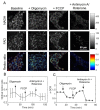Optical redox ratio identifies metastatic potential-dependent changes in breast cancer cell metabolism
- PMID: 27895979
- PMCID: PMC5119579
- DOI: 10.1364/BOE.7.004364
Optical redox ratio identifies metastatic potential-dependent changes in breast cancer cell metabolism
Abstract
The development of prognostic indicators of breast cancer metastatic risk could reduce the number of patients receiving chemotherapy for tumors with low metastatic potential. Recent evidence points to a critical role for cell metabolism in driving breast cancer metastasis. Endogenous fluorescence intensity of nicotinamide adenine dinucleotide (NADH) and flavin adenine dinucleotide (FAD) can provide a label-free method for assessing cell metabolism. We report the optical redox ratio of FAD/(FAD + NADH) of four isogenic triple-negative breast cancer cell lines with varying metastatic potential. Under normoxic conditions, the redox ratio increases with increasing metastatic potential (168FARN>4T07>4T1), indicating a shift to more oxidative metabolism in cells capable of metastasis. Reoxygenation following acute hypoxia increased the redox ratio by 43 ± 9% and 33 ± 4% in the 4T1 and 4T07 cells, respectively; in contrast, the redox ratio decreased 14 ± 7% in the non-metastatic 67NR cell line. These results demonstrate that the optical redox ratio is sensitive to the metabolic adaptability of breast cancer cells with high metastatic potential and could potentially be used to measure dynamic functional changes that are indicative of invasive or metastatic potential.
Keywords: (170.1530) Cell analysis; (170.2520) Fluorescence microscopy; (170.2655) Functional monitoring and imaging.
Figures




Similar articles
-
Potential Biomarker for Triple-Negative Breast Cancer Invasiveness by Optical Redox Imaging.Adv Exp Med Biol. 2021;1269:247-251. doi: 10.1007/978-3-030-48238-1_39. Adv Exp Med Biol. 2021. PMID: 33966225 Free PMC article.
-
Metabolic plasticity of metastatic breast cancer cells: adaptation to changes in the microenvironment.Neoplasia. 2015 Aug;17(8):671-84. doi: 10.1016/j.neo.2015.08.005. Neoplasia. 2015. PMID: 26408259 Free PMC article.
-
Multi-Modal Investigation of Metabolism in Murine Breast Cancer Cell Lines Using Fluorescence Lifetime Microscopy and Hyperpolarized 13C-Pyruvate Magnetic Resonance Spectroscopy.Metabolites. 2024 Oct 15;14(10):550. doi: 10.3390/metabo14100550. Metabolites. 2024. PMID: 39452931 Free PMC article.
-
Types of advanced optical microscopy techniques for breast cancer research: a review.Lasers Med Sci. 2018 Dec;33(9):1849-1858. doi: 10.1007/s10103-018-2659-6. Epub 2018 Oct 11. Lasers Med Sci. 2018. PMID: 30311083 Review.
-
Reduced nicotinamide adenine dinucleotide (NADH) fluorescence for the detection of cell death.Anticancer Agents Med Chem. 2009 Nov;9(9):1012-7. doi: 10.2174/187152009789377718. Anticancer Agents Med Chem. 2009. PMID: 19663784 Review.
Cited by
-
Two-Photon-Excited FLIM of NAD(P)H and FAD-Metabolic Activity of Fibroblasts for the Diagnostics of Osteoimplant Survival.Int J Mol Sci. 2024 Feb 13;25(4):2257. doi: 10.3390/ijms25042257. Int J Mol Sci. 2024. PMID: 38396933 Free PMC article.
-
Spatial Regulation of Mitochondrial Heterogeneity by Stromal Confinement in Micropatterned Tumor Models.Sci Rep. 2019 Aug 1;9(1):11187. doi: 10.1038/s41598-019-47593-8. Sci Rep. 2019. PMID: 31371796 Free PMC article.
-
Visualization of Breast Cancer Metabolism Using Multimodal Nonlinear Optical Microscopy of Cellular Lipids and Redox State.Cancer Res. 2018 May 15;78(10):2503-2512. doi: 10.1158/0008-5472.CAN-17-2618. Epub 2018 Mar 13. Cancer Res. 2018. PMID: 29535219 Free PMC article.
-
Metabolic Changes in Maternal and Cord Blood in One Case of Pregnancy-Associated Breast Cancer Seen by Fluorescence Lifetime Imaging Microscopy.Diagnostics (Basel). 2021 Aug 19;11(8):1494. doi: 10.3390/diagnostics11081494. Diagnostics (Basel). 2021. PMID: 34441428 Free PMC article.
-
Autofluorescence imaging of endogenous metabolic cofactors in response to cytokine stimulation of classically activated macrophages.Cancer Metab. 2023 Nov 13;11(1):22. doi: 10.1186/s40170-023-00325-z. Cancer Metab. 2023. PMID: 37957679 Free PMC article.
References
-
- Henry N. L., Somerfield M. R., Abramson V. G., Allison K. H., Anders C. K., Chingos D. T., Hurria A., Openshaw T. H., Krop I. E., “Role of Patient and Disease Factors in Adjuvant Systemic Therapy Decision Making for Early-Stage, Operable Breast Cancer: American Society of Clinical Oncology Endorsement of Cancer Care Ontario Guideline Recommendations,” J. Clin. Oncol. 34(19), 2303–2311 (2016).10.1200/JCO.2015.65.8609 - DOI - PubMed
-
- Peto R., Davies C., Godwin J., Gray R., Pan H. C., Clarke M., Cutter D., Darby S., McGale P., Taylor C., Wang Y. C., Bergh J., Di Leo A., Albain K., Swain S., Piccart M., Pritchard K., Early Breast Cancer Trialists’ Collaborative Group (EBCTCG) , “Comparisons between different polychemotherapy regimens for early breast cancer: meta-analyses of long-term outcome among 100,000 women in 123 randomised trials,” Lancet 379(9814), 432–444 (2012).10.1016/S0140-6736(11)61625-5 - DOI - PMC - PubMed
-
- Cronin M., Sangli C., Liu M.-L., Pho M., Dutta D., Nguyen A., Jeong J., Wu J., Langone K. C., Watson D., “Analytical Validation of the Oncotype DX Genomic Diagnostic Test for Recurrence Prognosis and Therapeutic Response Prediction in Node-Negative, Estrogen Receptor-Positive Breast Cancer,” Clin. Chem. 53(6), 1084–1091 (2007).10.1373/clinchem.2006.076497 - DOI - PubMed
-
- Warburg O., Posener K., Negelein E., “The metabolism of the carcinoma cell,” The Metabolism of Tumors. New York, Richard R. Smith, Inc, 29169 (1931).
-
- Lin X., Zhang F., Bradbury C. M., Kaushal A., Li L., Spitz D. R., Aft R. L., Gius D., “2-Deoxy-D-glucose-induced cytotoxicity and radiosensitization in tumor cells is mediated via disruptions in thiol metabolism,” Cancer Res. 63(12), 3413–3417 (2003). - PubMed
Grants and funding
LinkOut - more resources
Full Text Sources
Other Literature Sources
